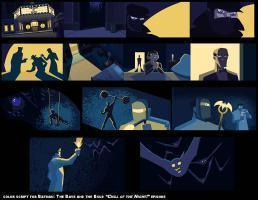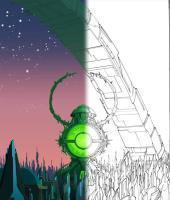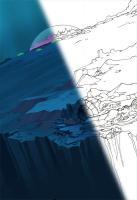Backstage - Interviews - William Dunn
The World’s Finest caught up again with William Dunn, Background Paint Supervisor for Batman: The Brave and The
Bold, to discuss his work on the acclaimed animated series. Dunn took a few moments out of his busy
schedule to answer the following queries...
 To start things off, can you fill us in on who you are and what you do?
To start things off, can you fill us in on who you are and what you do?
My name is Bill Dunn and I'm the background paint supervisor for Batman: The Brave and the Bold.
Concerning background work, can you run us through the process in creating a background for an animated series?
It's safe to assume it's more than just painting buildings and streets!
Once the script is ready, the director will hand it off to the design department
(prop, character and background layout) for "pre-design". Pre-design is where the design department will make a first pass at a
design and where James Tucker will give his notes. The designs are then handed off to the storyboard artists. After it is
storyboarded, adjustments might be made in the designs. Once finalized, the characters and props will go to our color key
department and the background designs will go to me in the background paint department.
Once I get backgrounds, I will have a meeting with the director of the episode. The director and I will go over the model pack of BGs and the
storyboard. In Batman: The Brave and the Bold, it was really important that the color served the story. This was done in two ways. First it helped tell the story in what
I would call a mechanical way. By this, I mean that color pallet set the location: Is it in Gotham? Is it on an alien planet? Is it underwater?
Batman: The Brave and the Bold had Batman go to many different locals and we tried to make each one have it's own individual look.
Also tied into this, the color set the time that the scene took place: Is it day or night? Is this a flashback, if so how long ago did the
event happen? The second way color was used to help tell the story was in an emotional sense. Is this supposed to be a happy, sad or
frightening scene? I think in a lot of ways, color has much in common with music as far as pushing the emotional narrative of a scene.
Also at this point either James or the directors might suggest a movie or a T.V. show that they may want to see as an influence to the color.
Whether it was the old Hammer films for the "Trial of the Demon" episode, "Fantastic Voyage" for the "Journey to the Center of the Bat!" episode
or "The Abominable Dr. Phibes" for the "Mayhem of the Music Meister!", Batman: The Brave and the Bold dipped from many wells for inspiration.
Once all of that is figured out, I will then go in and "color script" the entire episode. Color scripting is where the color pallets for every
scene is figured out and to make sure there is a "flow" from scene to scene. If you notice, most times the color pallet for the teaser of an
episode is not the same as the rest of the episode. This is done to make sure that the teaser felt like it's part of it's own story and was
separated from the rest of the episode. These color pallets are not finished background paintings by the way and are only color swatches that
I have done in Photoshop. I do this so I can show James and the directors what I have in mind before too much time is invested in painting
the backgrounds. If James doesn't like the color choice or if it has to be changed at this point for whatever reason, no big deal, only a
color swatch needs to be adjusted and not a whole background painting.
After the color pallet is worked out, I will hand off backgrounds with color swatches on them to Craig Cuqro and Christina Long in the color
key department. Craig and Christina make sure that the characters will "sit" in a background and that there is a color harmony between the
characters and the backgrounds. A good example of this is in the "Chill of the Night" episode. Notice how color key has colored the characters
in the Tiki Tavern scene to make the characters look as if they are lit by the light of a seedy night club or how the characters look in the
nightmarish flashback scene of the charity gala. Craig and Christina will also create special lighting keys for every time a flashlight, a
laser, an explosion, what have you, affect the characters. Along with these keys, very detailed notes are written and sent to overseas to make
sure the right character color key is used in the right scene. This can get very complicated and is very important to the finished look of
the color in a scene.
Meanwhile, while that is happening in the color key department, I've handed off backgrounds with my color pallets to background painters
Hector Martinez and David McBride. All three of us will then paint the backgrounds for the episode.
As a semi-follow-up to the previous questions, how many backgrounds are created on average per show?
And additionally, is it a difficult task to make sure the different background artists create consistently work per episode?
That's actually a tough question because the background amount between seasons and even episodes varied. Season 1
background counts started out averaging 35 to 45 per episode (with the the exception of the first Bat-Mite and the Music Meister
episodes which both had bigger background counts that were about 80 backgrounds each). Season 2 background counts averaged 50 to 60 per episode
and season 3 averaged 60 per episode, although there was an episode that was over 90 backgrounds. I think because I do a color script in
the beginning of the process and that there were paint guidelines established in the beginning of the production, everyone's backgrounds
hook up pretty well.
 As another semi-follow-up, do you find there are misconceptions when it comes to this profession? How would one become a
background artist for a series?
As another semi-follow-up, do you find there are misconceptions when it comes to this profession? How would one become a
background artist for a series?
I guess one of the misconceptions I used to hear is that we can push a button and that the computer will do all of
the work. I hear that less now though. I guess another is that the backgrounds we paint are the ones you see in
the finished episodes. Sadly this isn't the case. Overseas will use the the paintings we send as color guides and repaint them.
As far as becoming a background artist, I would suggest if someone wanted to become one, I would try to take a lot of painting and color
theory classes, as well as do a lot of landscape painting. Then I would submit my portfolio to the studios. I didn't start out my
professional career in animation. I worked as a colorist in comics for about three years and then I moved to L.A. to switch careers.
My first gig in animation was designing props and it took me a few years to get a painting job.
As a comic
book-based series, there must be countless nods and homages peppered throughout each painting. Care to point out your favorites to the
fans?
There are so many that I like. I think some of my favorites were in the first Bat-Mite episode. For the shot
recreating the opening of Batman: The Animated Series with the lightning flash behind Bat-Mite, I was actually able to get a scan of the original production background
and have overseas drop it in. For the other Batman: The Animated Series scenes in that episode, we had John Calmette paint them (who was one of the original painters
on that series). Also for that episode, I had a fun time recreating backgrounds for the section that was inspired by Bob Clampett's "The Great
Piggy Bank Robbery". I also enjoyed painting the punk club for the Music Meister episode that looked a lot like the now gone CBGB
(some of the graffiti on the outside of the club has some very familiar names on it by the way). Also, there are a bunch in the
Doom Patrol episode that I like, for example, we have in the background of the Paris section "the painting that ate Paris" which
was from the Grant Morrison Doom Patrol run. I think you can probably do a whole article on all of the Easter Eggs that are in Batman:
The Brave and The Bold alone.
Can you run us through some abandoned concepts
for Batman: The Brave and The Bold? Was it difficult to come up with look for the series and deciding which to keep and
what to discard?
Originally I was really keen on pushing the comic bookness of the backgrounds. So I thought, what
is more comic bookish than zip-a-tone dot patterns? When I showed the samples to James, whereas he thought it was kind of cool,
he pointed out that if we trucked into a background, what would look like a small dot from far away, would look like a bunch of large
dinner plates close up. Plus there might be a problem if the camera pans along the dot pattern. It could vibrate on the screen.
He was right of course and it would have also been a logistical nightmare for overseas. So the zip-a-tone idea was dropped from the
backgrounds. We did later have the dot patterns make an appearance in the "Bat Boy and Rubin" section of "Bat-Mite Presents: Batman's
Strangest Cases". This was put in post though by (I believe) Matthew Girardi.
 You've also worked on The Batman. In basic terms, how would you describe the
difference between The Batman and Batman: The Brave and The Bold when it came to designing for the
show? You've also worked on The Batman. In basic terms, how would you describe the
difference between The Batman and Batman: The Brave and The Bold when it came to designing for the
show?
I didn't have that much input as far as designing the paint style of The Batman as
I did Batman: The Brave and The Bold, but I guess the big difference between the two shows were, first the use of line
work and second, the use of true black. I didn't want to use either of those things for Batman: The Brave and The Bold. I have nothing against line
work or true black, but we didn't think it would have suited the tone of the show. I think without the line work on the
backgrounds it gave the show a "cleaner" feeling and for exception of maybe a handful of times, we didn't use a true
black on a background after episode 8 or 9. It was always a dark color in the shadow areas and not black. This let the
nice thick line work of the characters to stand out and left room for the color key department to use black on a
character without fear that the character would disappear in to the background.
You state that your end of the production has ended for Batman: The Brave and The Bold. Can
you clarify and perhaps drop a hint or two about those final episodes you've worked on?
I can't drop any
hints on the final few episodes (and really why would you want me to spoil the surprise?), but I can say
this: Batman: The Brave and The Bold will end its 65 episode love letter to all things Batman with a fitting final
episode.
So, what can we expect from you in the future? Care to drop any hints as to where your name will appear
next?
Again I can't tell you what project I'll be working on next, but when it's announced, DC comic fans
will be very, very excited.
The World's Finest would like
to thank William Dunn for participating in this Q & A. More of Dunn's background work on Batman: The Brave and The Bold
can be found at Batman: The Brave and the Bold Background
Paint Blog.
Batman: The Brave and The Bold © Warner Bros. Entertainment Inc. “Batman” and all related characters and
elements are trademarks of and © DC Comics.
[ Back to Backstage ]
Batman: The Brave and the Bold and related characters are property of DC Comics and WB, 2001 - Present Day.
The World's Finest and everything relating to this site - copyright,
1998 - Present Day.
Proudly hosted by toonzone and popgeeks. Contact us.
|